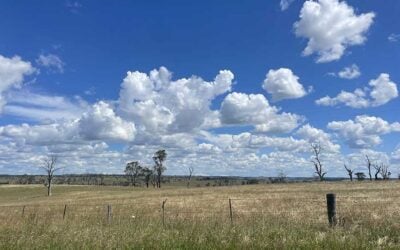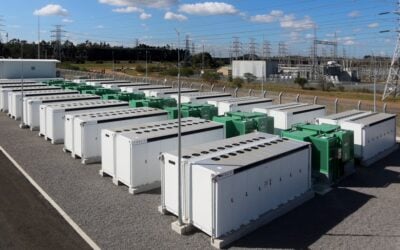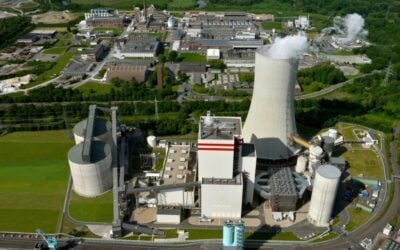Elon Musk launching Powerwall 2, along with Tesla's new solar roof tiles. Image: Tesla YouTube.
Tesla-SolarCity could become an energy equivalent to an Uber or AirBnB, with a merger between the two creating “an integrated sustainable energy company, which does not own any centralised generation assets”, one expert has commented.
Julian Jansen, analyst and energy storage research manager at Delta Energy & Environment (Delta EE), spoke to Energy-Storage.News about an investor presentation issued by Tesla ahead of the merger talks, which go to a shareholder vote on 17 November.
Enjoy 12 months of exclusive analysis
- Regular insight and analysis of the industry’s biggest developments
- In-depth interviews with the industry’s leading figures
- Annual digital subscription to the PV Tech Power journal
- Discounts on Solar Media’s portfolio of events, in-person and virtual
Tesla, led by CEO and chief product architect Elon Musk, and SolarCity, headed up by Musk’s cousins Lyndon and Peter Rive – CEO and CTO respectively – are seeking to become an integrated provider of electric vehicles, rooftop solar, battery energy storage and now also BIPV solar roof tiles.
At last week’s launch event for the solar roof tiles, Musk also launched Powerwall 2, with an increased 14kWh of storage capacity and a new look. The unveiling of the updated home storage system which will retail at US$5,500, followed the lower key announcement via Tesla’s official blog of the new generation of Powerpack commercial, industrial and utility-scale batteries.
Delta EE’s Jansen said that the unification of Tesla and SolarCity follows the path of convergence seen between energy storage and solar over the past couple of years and the acquisition “is really part of the wider transformation of the energy system”. While it was somewhat novel for an energy storage manufacturer to move into solar through acquisition, there are plenty of examples of other big companies moving from solar PV, automobiles or energy into energy storage, such as Panasonic, Mercedes-Benz and Total.
Jansen said therefore that the new entity created by a potential merger would be in some ways analogous to taxi app Uber, which hires out drivers and their cars rather than owning its own fleet of cars.
“It’s not hard to imagine Tesla evolving into a company that provides new energy solutions for different customers groups, connecting customers and aggregating loads and distributed generation, as well as providing flexibility to the system,” Jansen said.
“As such they would truly be an integrated sustainable energy company, which does not own any centralised generation assets – i.e. connecting distributed generation with local consumption and energy storage. Thus in a sense being the intermediary, like an Uber or AirBnB – who do not own assets – in the energy sector.”
However, the Delta EE analyst also pointed out that while Tesla still guarantees media coverage and headlines with almost every move Musk makes, there are rivals out there already going much further than the Silicon Valley carmaker in providing aggregated services and energy trading platforms using energy storage. Jansen pointed out the examples of Germany’s Sonnen, which has already launched a peer-to-peer (P2P) energy trading platform and grid-balancing frequency regulation service in the residential space and the US’ Green Charge and Stem in the commercial and industrial (C&I) segment.
Strategic merger or strategic bail-out
In a lengthy blog posted yesterday by Tesla on the merger ahead of a conference call with financial analysts, the company highlighted the expected importance of providing services with energy storage beyond backup power and hedging against electricity rate rises, by adding grid services.
Integrating Tesla and SolarCity into one company, “enhances the opportunity for the combined company to sell grid services into the US$50 billion per year distribution and transmission market”, the company said. It described this opportunity as more significant to the business model than behind the meter value to individual customers.
The blog post, while illuminating some aspects of the financials, such as a claim that SolarCity will add US$500 million to Tesla’s balance sheet, was also enormously bullish on the merged company's prospects.
“Additionally, with the new products that we have shown, we expect that solar’s share of the nation’s US$400 billion in annual retail electricity sales will increase more than anyone currently expects,” the blog said.
In the call with analysts, Tesla-SolarCity executives including Lyndon Rive, Elon Musk and Tesla CFO Jason Wheeler talked up the merged company’s synergies, including the potential to upsell Powerwall’s to SolarCity’s installed base of 300,000 solar customers, calling it a “very, very simple retrofit procedure”.
The CEO of one investment company, Rockfire Capital, wrote to Energy-Storage.News to highlight that some had pinpointed the merger as “such a bad financial deal that it has been described as a bail-out” of SolarCity by the now-profitable Tesla adding that “it can only be happening for strategic reasons”.






